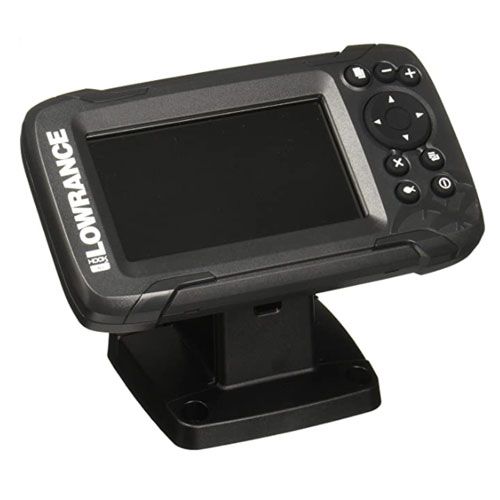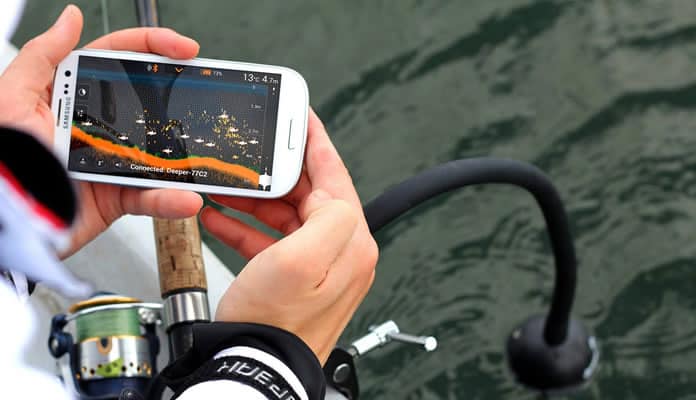
For many of us, kayak fishing is our favorite hobby. There’s nothing better than enjoying a nice day in your kayak while casting the bait. Of course, you always hope to catch some fish too. Adding a fish finder to your kayak fishing rig can make a huge difference in the outcome.
A fish finder is an awesome device that allows you to see the fish that are swimming under and around your kayak. This way you know where to go to potentially make a bigger catch. On top of this, the best kayak fish finders allow you to see the type of fish, bottom configuration, and have GPS to make navigation easier.
To help you find the perfect fish finder for your kayak, we have created a buying guide that breaks down all of the features and explains them in detail. Additionally, the fantastic kayak fish finders on our list will make sure you never go home empty-handed, so don’t miss out.
OUR TOP PICK
Deeper PRO+ GPS Kayak Fish Finder
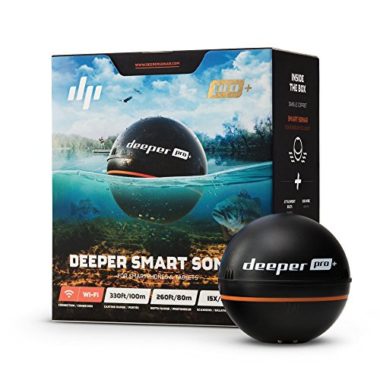
- Stand Out Features - Why We Love It
- Dual-beam scanner with 0.5-inch target separation
- GPS feature allows creating bathymetric maps
- Works with both Android and iOS devices
- App displays depth, terrain, vegetation, and fish
- Installs quickly without any cables
Range: 260 feet
Frequency: 290 and 90 kHz
Weight: 3.52 ounces
Dimensions: 3 x 5.3 x 5.9 inches
Display diagonal: Uses smartphone screen
Scanning angle: 15° or 55°
GPS: Yes
EDITORS CHOICE
Garmin Striker 4 GPS
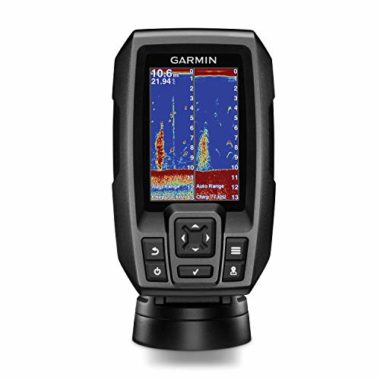
- Stand Out Features - Why We Love It
- Exceptional range in any type of water
- Bright 3.5-inch color screen
- IPX7 waterproof rating
- Waypoint map for easier navigation
- CHIRP sonar for gathering more information
Range: 1600 feet (freshwater), 750 feet (saltwater)
Frequency: 50/77/200 kHz
Weight: 8.1 ounces
Dimensions: 3.6 x 1.6 x 5.9 inches
Display diagonal: 3.5 inches
GPS: Yes
BEST VALUE
ReelSonar iBobber Wireless
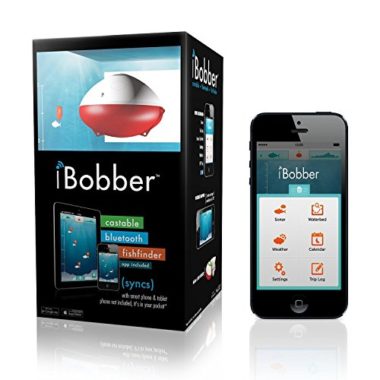
- Stand Out Features - Why We Love It
- Pairs with both Android and iOS smartphones
- Bluetooth connection with a 100-foot range
- LED beacon makes night kayak fishing easier
- Strike alarm when the device picks up fish
- Rechargeable battery lasts for 10+ hours
Range: 135 feet
Weight: 1.58 ounces
Dimensions: 3 x 3 x 3 inches
Display diagonal: Uses smartphone screen
GPS: Yes
HawkEye FishTrax 1C
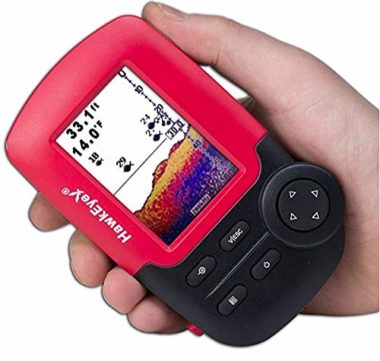
- Stand Out Features - Why We Love It
- VirtuView HD color screen shows fish and terrain
- FishTrax sonar gives precise readings at greater depths
- FishArc and FishID show the type and size of fish
- Audible alarm when fish are within range
- Waterproof to IPX7 standards
Range: 240 feet
Frequency: 83/200 kHz
Weight: 10.2 ounces
Dimensions: 6 x 3 x 2 inches
Display size: 2 x 1.6 inches
Scanning angle: 14° or 26°
GPS: No
Venterior VT-FF001 Portable
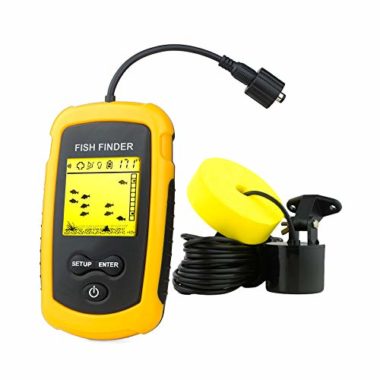
- Stand Out Features - Why We Love It
- Five sensitivity setting to choose from
- Shows water depth, fish, and bottom configuration
- Display backlight makes reading at night easier
- Runs on 4 disposable AAA batteries
- Generous 2-year warranty included
Range: 328 feet
Frequency: 77/200 kHz
Weight: 15.2 ounces
Dimensions: 9.6 x 2.2 x 5.9 inches
Scanning angle: 45°
GPS: No
Lowrance HOOK2 4X
- Stand Out Features - Why We Love It
- SolarMAX display is easy to read and use
- One-touch shortcuts to important features
- Auto-tuning sonar gives more precise information
- Wide-angle cone shows a larger area than other models
- Transducer is easy to install and connect
Weight: 2.2 pounds
Dimensions: 3.3 x 6.5 x 3.8 inches
Display diagonal: 4.3 inches
GPS: No
Lucky Handheld Portable
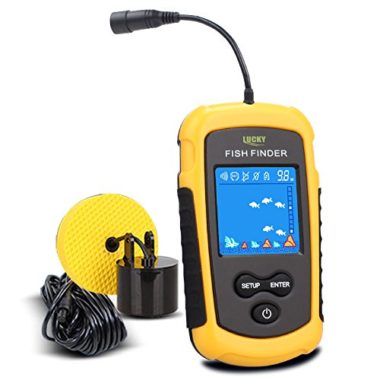
- Stand Out Features - Why We Love It
- Adjustable transducer float for easier positioning
- Wide scanner cone picks up more information
- Display shows weeds and rocks on the bottom
- Five different sensitivity modes
- Smart alarms when fish are detected
Range: 328 feet
Frequency: 200 kHz
Weight: 1.1 pounds
Dimensions: 5.9 x 3.9 x 3.9 inches
Scanning angle: 45°
GPS: No
Humminbird 410160-1 PiranhaMax 4.3 DI
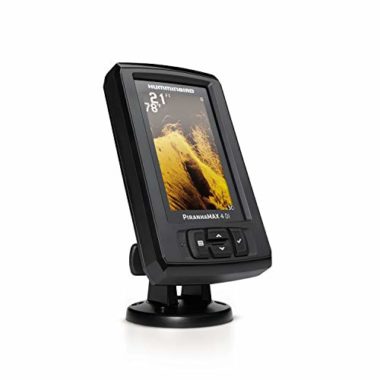
- Stand Out Features - Why We Love It
- Large 4.3-inch display makes reading easier
- IPX7 waterproof rating prevents water damage
- Dual-beam sonar significantly improves coverage
- Adjustable fish and depth alarms
- Quick installation on a rotating mount
Range: 320 feet
Frequency: 200/455 kHz
Weight: 2 pounds
Dimensions: 3.91 x 7.34 x 3.62 inches
Display diagonal: 4.3 inches
Scanning angle: 16°, 28°, and 74°
GPS: No
Lowrance Hook-3X
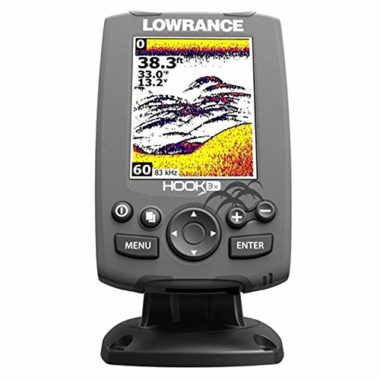
- Stand Out Features - Why We Love It
- LED-backlit display for easier nighttime use
- Built-in temperature sensor in the transducer
- Dual-frequency sonar for a more complete image
- Shows fish, bottom hardness, and thermoclines
- Advanced Signal Processing (ASP) makes images clearer
Range: 400 feet
Frequency: 83/200 kHz
Weight: 2 pounds
Dimensions: 3.8 x 1.9 x 6.5 inches
Display diagonal: 3 inches
Scanning angle: 60°
GPS: No
FishHunter PRO Wireless
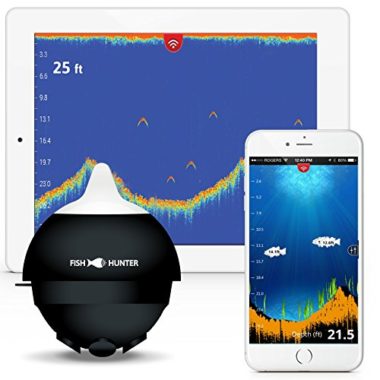
- Stand Out Features - Why We Love It
- Can be trolled up to 2.5 mph
- Triple-frequency for most precise readings
- Rechargeable battery with a 10-hour life
- Wirelessly connects to your device
- Multi-feature app is easy to use
Range: 150 feet
Frequency: 381/475/675 kHz
Weight: 6.4 ounces
Dimensions: 1 x 1 x 1 inches
Display diagonal: Uses smartphone display
GPS: No
How to Choose The Best Fish Finder For Kayaks – Buying Guide
Screen
Size: Good screen size allows you to easily read the information on your fishfinder. Fishfinder screens sizes range from 3 to upwards of 6 inches (diagonal) with the best kayak fish finders usually measuring between 4 and 5 inches. A display 4 inches or larger is usually enough to see the fish clearly.
Resolution: In addition to size, the display resolution is equally important. Screen resolution is measured by the amount of dots they contain (pixels), much like that of a tv or a smartphone.
We don’t recommend getting a display lower than 320 x 240, as the detail won’t be high enough. Going above this mark will allow you to see the outline of fish even when the sun is bright.
Color vs Black/White: Almost all modern fish finders are equipped with colored screens. Compared to monochrome, these show much more detail, giving you a better idea of what’s going on in the water. When you’re in dark overcast conditions or experiencing intense glare, colored screens are far easier to read.
Transducer (Sonar)
The transducer is an essential part of every fish finder – it emits the sound waves and picks up the echoes, allowing the device to show you where the fish are.
Frequency: Measured in kilohertz (kHz), the frequency of a shallow-water fish finder ranges from 50 to 100 kHz, while a deep water fish finder uses frequencies around 200 kHz.
Power: The fish finder power determines how efficient it is in sending and picking up signals. A more powerful device will emit stronger signals which are great for kayak fishing in deeper water.
Cone Angles & Beams
Cone angles refer to the imaging angle (cone) the finder can show. Depending on the cone width, this is also known as down and side imaging.
Down imaging: The sonar uses a narrow-angle and reads what’s directly underneath the boat. This type is better for kayak fishing in deeper waters because the wave travels farther.
Side imaging: The sonar uses a wide-angle that shows what’s on the sides of the boat. While these waves won’t go very deep, they are great for showing what’s around you which is a plus for fishing in shallow water.
You may also like:
Water depth
Before buying a fish finder, think about the depth you’ll be fishing in because not all models can be used in deep waters. With this said, fish finders that use a dual-frequency are generally great for deeper conditions. For example, a 77/200kHz finder will use the 77 for shallow waters and 200 kHz when it needs an extended range.
Additional features
3D Sonar: Instead of a grainy set of dots on the display, a 3D sonar shows a detailed view of the area under you. It will allow you to see the slope of the floor and even the plant life in great detail.
GPS: GPS navigation is always a nice feature to have. Some manufacturers even combine it with pre-loaded maps that allow you to create waypoints and fully plan your kayak fishing route.
CHIRP: A model equipped with the Compressed High-Intensity Radar Pulse (CHIRP) technology is going to give a superior image compared to standard transducers.
Power Source
It makes sense that more powerful devices with larger screens require more power to operate. Luckily, the best kayak fish finders often have built-in batteries that last upwards of 10 hours.
A fish finder with a rechargeable battery is probably the most convenient. When they run out of juice, simply plug them into an outlet and you’re good to go. Alternatively, some portable fish finders use different types of disposable batteries. These batteries last much longer than small rechargeable options, but you have to buy new ones once they’re drained.
Related Review: Portable Fish Finder
Single Product Fishing Kayaks Reviews:
- Sevylor Coleman Colorado 2-Person Fishing Kayak Review
- Elkton Outdoors Cormorant Inflatable 2 Person Fishing Kayak Review
FAQs

Q: How Does A Fish Finder Work On A Kayak?
A fish finder uses a sonar (sound waves) to determine where the fish are. Essentially, the transducer emits sound waves and then picks up the echo. This allows the device to determine where objects are, based on how long the signal takes to get back to the starting point.
Q: Where To Mount Fish Finder On A Kayak?
The fish finder unit should be mounted within arms reach, which is why most kayak anglers choose to mount it on the side of the kayak. While putting it on the nose is perhaps easier to read, operating it is going to be harder.
Q: Do I Need A Kayak Fish Finder With GPS?
While you don’t absolutely need it, having a GPS-enabled fish finder is great. It allows you to see your exact position and where the fish are relative to you. Seeing a map and your location on the display makes navigating the water much easier, especially in low-light conditions.
Q: Are Fish Finders Waterproof?
Most fish finders are water-resistant, but not waterproof. It means that they are perfectly safe to get splashed on all day, but that you shouldn’t submerge them in water.
Q: What To Look For In A Fish Finder?
The main features to look for are good screen size, resolution, transducer power, and frequency. This covers the basics of showing a reliable image on your device. On top of this, going with a multi-angle sonar will expand your kayak fishing range to both shallow and deep water.
Related Review: Fish FinderGlobo Surf Overview
A fish finder can make all the difference when trying to catch some fish in your kayak. Instead of guessing, this great device will show you exactly where the fish are. Hopefully, our guide and reviews have helped you figure out which are the best kayak fish finders, so you can always count on the best catch.
More Kayak Reviews:
- Fishing Kayaks
- Tandem Fishing Kayaks
- Fishing Float Tube
- Stand Up Fishing Kayaks
- Ocean Fishing Kayaks
- Sit On Top Fishing Kayaks
- Kayak Paddles For Fishing
- Kayak Fishing Accessories
- Pedal Fishing Kayaks
- Kayak Fishing Rods
- River / Fly Fishing Kayaks
- Kayak Fishing Nets
- Modular Fishing Kayaks
Fishing Kayak’s Guides:
Globo Surf Overview
A fish finder can make all the difference when trying to catch some fish in your kayak. Instead of guessing, this great device will show you exactly where the fish are. Hopefully, our guide and reviews have helped you figure out which are the best kayak fish finders, so you can always count on the best catch.
More Kayak Reviews:
- Recreational Kayak
- Lightweight Kayak
- Tandem Fishing Kayak
- Beginner Kayak
- Kayak Seat
- Motorized Kayak
- Fishing Canoe
- Ocean Kayak
- Folding Kayak



